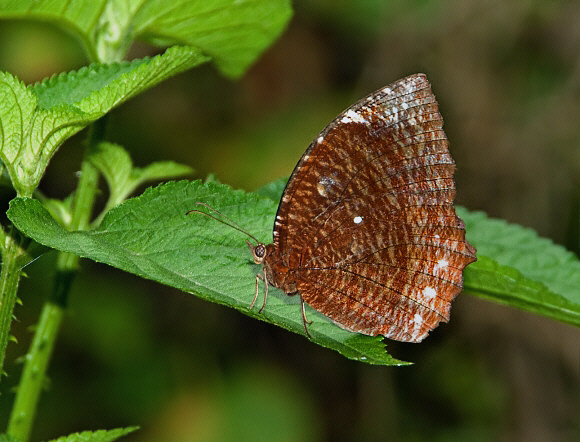
Introduction
The genus Elymnias comprises of 45 species – 37 in the Oriental region, 1 in Australia, 4 in Papua New Guinea and 3 in Africa (although the African species are placed in another genus Elymniopsis by some workers).
On the upperside, the male is bluish black, with a series of large purplish or bluish spots around the apex and wing margins. It is considered to be a Batesian mimic of the Striped Blue Crow Euploea mulciber – a Danaine which has been demonstrated to be unpalatable to birds.
The female of subspecies undularis from India and Sri Lanka has a large orange patch on each wing, and is probably a mimic of the unpalatable Danaine, the Common Tiger Danaus genutia.
On the underside, both sexes of all of the subspecies are brown, finely marbled with reddish, and with a smudge of whitish scales near the apex of the forewing. On the hindwing there is usually a white spot just beyond the discal cell, but this varies in size from one individual to another, and in some examples is entirely absent.
Elymnias hypermnestra occurs in India, Sri Lanka, Myanmar, Laos, South Vietnam, Thailand, West Malaysia, Palawan, the Philippines, Taiwan, Sumatra, Borneo, Java and Bali.
Habitats
This species occurs in primary and secondary forest, oil palm (Elaeis guineensis) plantations, and parks, at elevations between sea level and about 800 metres.
Lifecycle
The egg is pale green, spherical and covered in small pits or indentations. It is laid singly on the leaves of palms (Arecaceae) including Arenga engleri, Cocos nucifera, Livistona chinensis, Elaeis guineensis, Licuala chinensis, Calamus rotang, Calamus pseudo-tenuis, Calamus thwaitesii, Phoenix lourerii and Phoenix humilis.
The caterpillar when fully grown is bright green, with a pair of prominent yellow lines along the back, and finer lines on the sides. It’s head is pinkish-brown and ornamented with a pair of short curved horns, and the tail bears a pair of similarly coloured long caudal prongs. It is crepuscular in behaviour – feeding at dawn and dusk.
The chrysalis is extremely pretty, being emerald green and marked with yellow-edged bright red streaks and dashes along the back, thorax and the dorsal edge of the wing cases. It is suspended by the cremaster from a silk pad, beneath a leaf or stem of the foodplant.
Adult behaviour
In India and Sri Lanka, I have often seen this species flying on hot sunny afternoons, but in Malaya and Borneo it tends to only be active very early in the day, or in overcast conditions.
Unlike most Satyrines (which usually to fly close to the ground), the butterflies tend to fly around the top of bushes or the lower branches of trees. They have a delicate slow flight – a mixture of fluttering and gliding, and when they land they invariably settle on a leaf, high up in a bush, and usually beyond camera reach. At all times they are nervous and very alert, and at the slightest disturbance will immediately take flight, only to resettle on another high leaf, usually somewhere even less accessible to the photographer!
